Strategic Human Resource Management Report: Integration & Models
VerifiedAdded on 2023/06/07
|19
|4441
|56
Report
AI Summary
This report provides a detailed overview of strategic human resource management (SHRM), emphasizing its role in aligning business and HR strategies to achieve organizational goals. It explores theoretical models of SHRM, including high-performance, resource-based, and competency models, and discusses vertical and horizontal integration within organizations. The report also examines theoretical perspectives on employment relations, such as unitary and pluralist perspectives, and the roles of various actors within the employment relationship. It concludes with recommendations for implementing effective HR strategies, including a contingency approach that adapts to changing business needs, and highlights the importance of positive employee relations in improving organizational performance. This resource is ideal for students seeking to understand the complexities of strategic HRM and its impact on organizational success.

Strategic uman Resource ManagementH
Paraphrase This Document
Need a fresh take? Get an instant paraphrase of this document with our AI Paraphraser
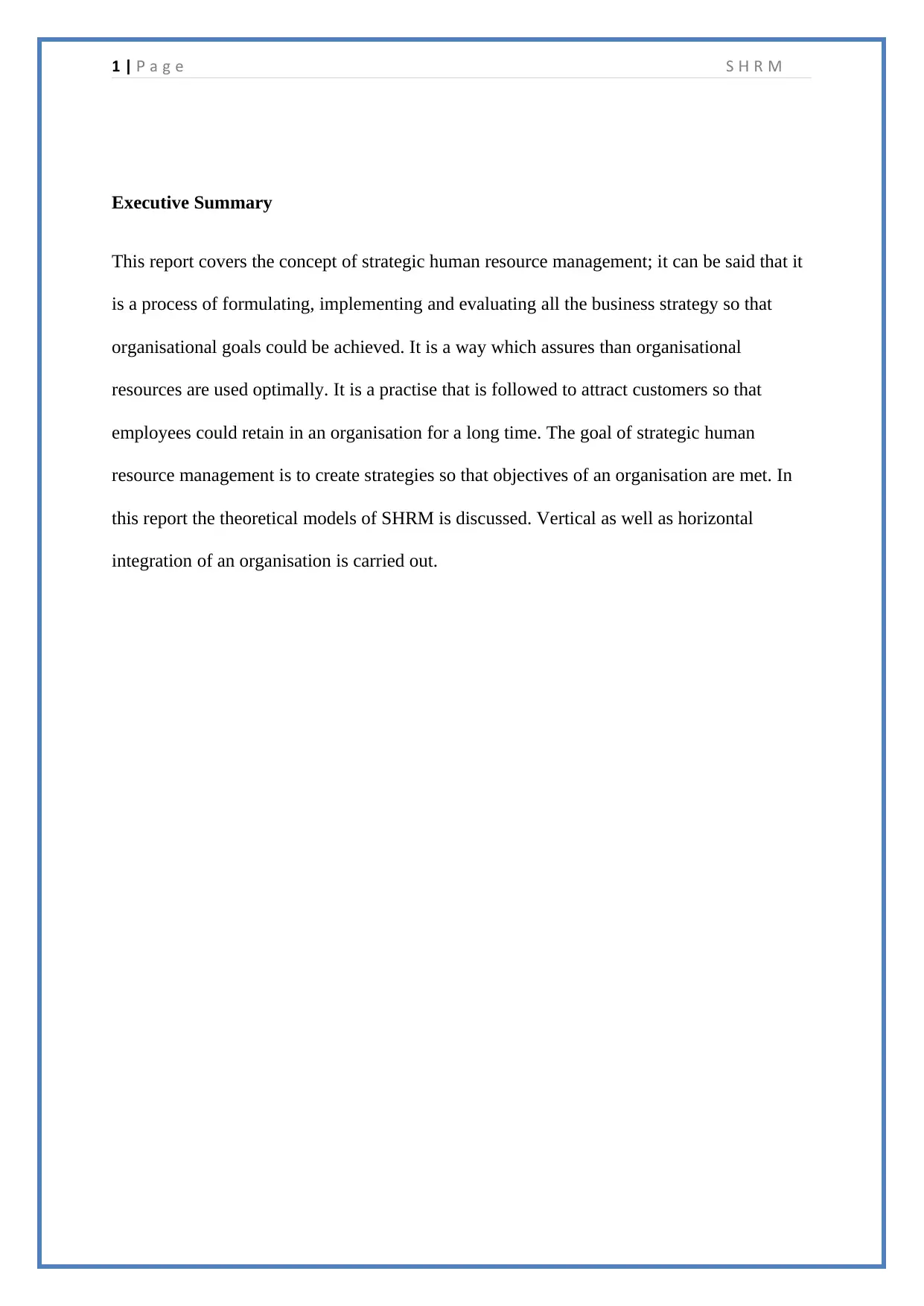
1 | a g eP S R MH
Executive Summary
This report covers the concept of strategic human resource management; it can be said that it
is a process of formulating, implementing and evaluating all the business strategy so that
organisational goals could be achieved. It is a way which assures than organisational
resources are used optimally. It is a practise that is followed to attract customers so that
employees could retain in an organisation for a long time. The goal of strategic human
resource management is to create strategies so that objectives of an organisation are met. In
this report the theoretical models of SHRM is discussed. Vertical as well as horizontal
integration of an organisation is carried out.
Executive Summary
This report covers the concept of strategic human resource management; it can be said that it
is a process of formulating, implementing and evaluating all the business strategy so that
organisational goals could be achieved. It is a way which assures than organisational
resources are used optimally. It is a practise that is followed to attract customers so that
employees could retain in an organisation for a long time. The goal of strategic human
resource management is to create strategies so that objectives of an organisation are met. In
this report the theoretical models of SHRM is discussed. Vertical as well as horizontal
integration of an organisation is carried out.
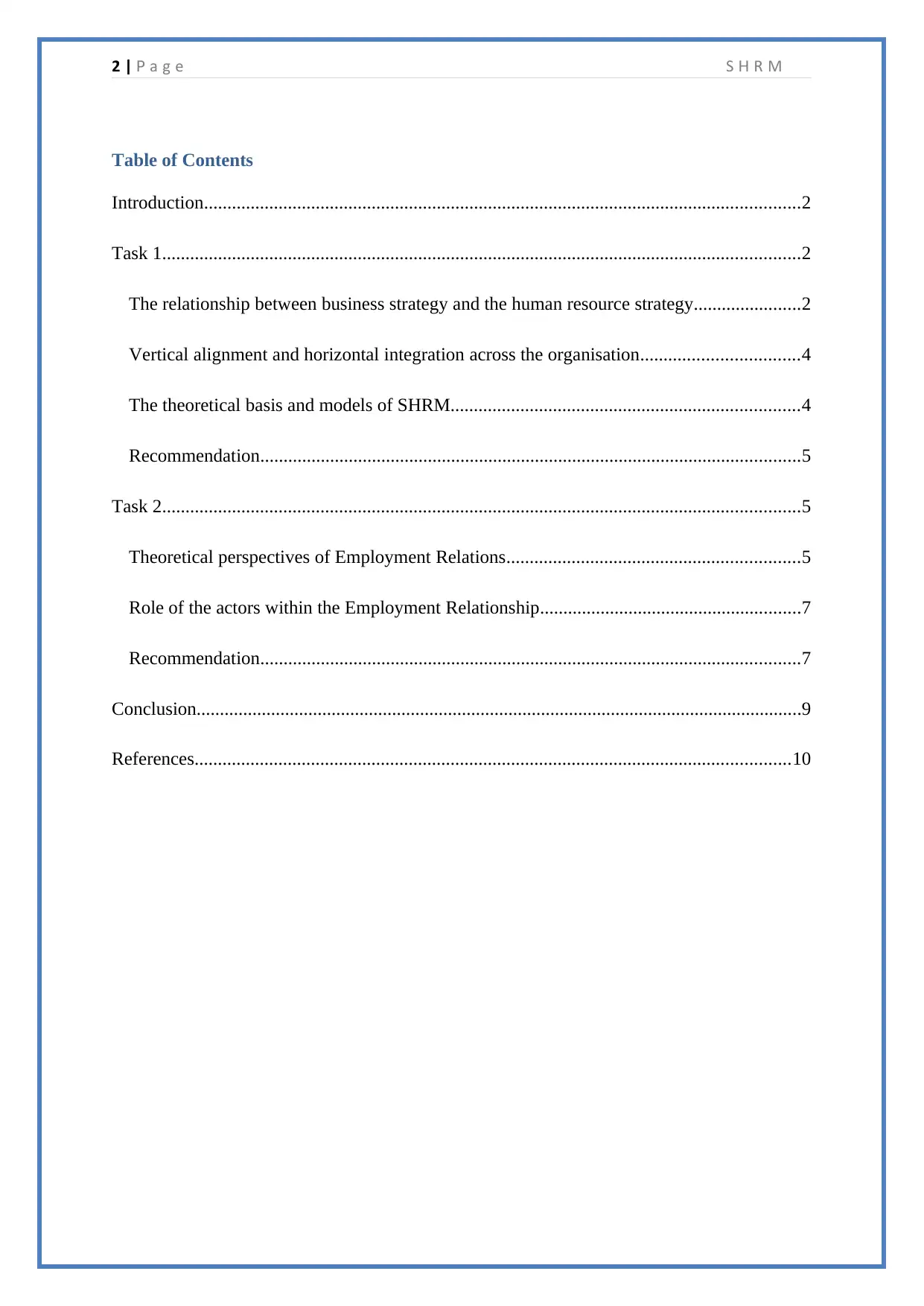
2 | a g eP S R MH
Table of Contents
Introduction................................................................................................................................2
Task 1.........................................................................................................................................2
The relationship between business strategy and the human resource strategy.......................2
Vertical alignment and horizontal integration across the organisation..................................4
The theoretical basis and models of SHRM...........................................................................4
Recommendation....................................................................................................................5
Task 2.........................................................................................................................................5
Theoretical perspectives of Employment Relations...............................................................5
Role of the actors within the Employment Relationship........................................................7
Recommendation....................................................................................................................7
Conclusion..................................................................................................................................9
References................................................................................................................................10
Table of Contents
Introduction................................................................................................................................2
Task 1.........................................................................................................................................2
The relationship between business strategy and the human resource strategy.......................2
Vertical alignment and horizontal integration across the organisation..................................4
The theoretical basis and models of SHRM...........................................................................4
Recommendation....................................................................................................................5
Task 2.........................................................................................................................................5
Theoretical perspectives of Employment Relations...............................................................5
Role of the actors within the Employment Relationship........................................................7
Recommendation....................................................................................................................7
Conclusion..................................................................................................................................9
References................................................................................................................................10
⊘ This is a preview!⊘
Do you want full access?
Subscribe today to unlock all pages.

Trusted by 1+ million students worldwide

3 | a g eP S R MH
Introduction
The human resource management mainly focuses on recruiting and hiring of employees so
that benefits could be offered to an organisation. Strategic human resource management is a
practise that is used to attract the employees by developing rewards. The motive of strategic
human resource management is to retain employees for long term. The reason behind the
success of an organisation is strategic human resource management. The importance of
strategic human resource management is developing the goals so that organisational success
is achieved (Armstrong and Taylor, 2014) . It is a process that makes use of various HR
techniques like recruitment, employee relations so that organisation policies are implemented.
The importance of strategic human resource management is to support all the department and
work n a way to achieve common goals (Taylor, Doherty and McGraw, 2015) .
Task 1
The relationship between business strategy and the human resource
strategy
There exists a relationship between human resource strategy and business goals as they are
aligned in different ways. The ultimate objective of this relation is to make use of the
organisational assets in a maximum way. The goal is to make sure that human capital is used
and stakeholders are benefited. Some of the relation that exists between human resource
department and business strategy will be discussed below. On the other hand, business
strategy showcases the way through which organisation could succeed and goals of an
organisation could be achieved. Business strategy helps in identifying the direction in which
an organisation should proceed. The theory of human resource management is implemented
so that competitive advantage is improved (Taylor, Doherty and McGraw, 2015). It is said
that human resource department is an integral part of business strategy. The role of business
Introduction
The human resource management mainly focuses on recruiting and hiring of employees so
that benefits could be offered to an organisation. Strategic human resource management is a
practise that is used to attract the employees by developing rewards. The motive of strategic
human resource management is to retain employees for long term. The reason behind the
success of an organisation is strategic human resource management. The importance of
strategic human resource management is developing the goals so that organisational success
is achieved (Armstrong and Taylor, 2014) . It is a process that makes use of various HR
techniques like recruitment, employee relations so that organisation policies are implemented.
The importance of strategic human resource management is to support all the department and
work n a way to achieve common goals (Taylor, Doherty and McGraw, 2015) .
Task 1
The relationship between business strategy and the human resource
strategy
There exists a relationship between human resource strategy and business goals as they are
aligned in different ways. The ultimate objective of this relation is to make use of the
organisational assets in a maximum way. The goal is to make sure that human capital is used
and stakeholders are benefited. Some of the relation that exists between human resource
department and business strategy will be discussed below. On the other hand, business
strategy showcases the way through which organisation could succeed and goals of an
organisation could be achieved. Business strategy helps in identifying the direction in which
an organisation should proceed. The theory of human resource management is implemented
so that competitive advantage is improved (Taylor, Doherty and McGraw, 2015). It is said
that human resource department is an integral part of business strategy. The role of business
Paraphrase This Document
Need a fresh take? Get an instant paraphrase of this document with our AI Paraphraser
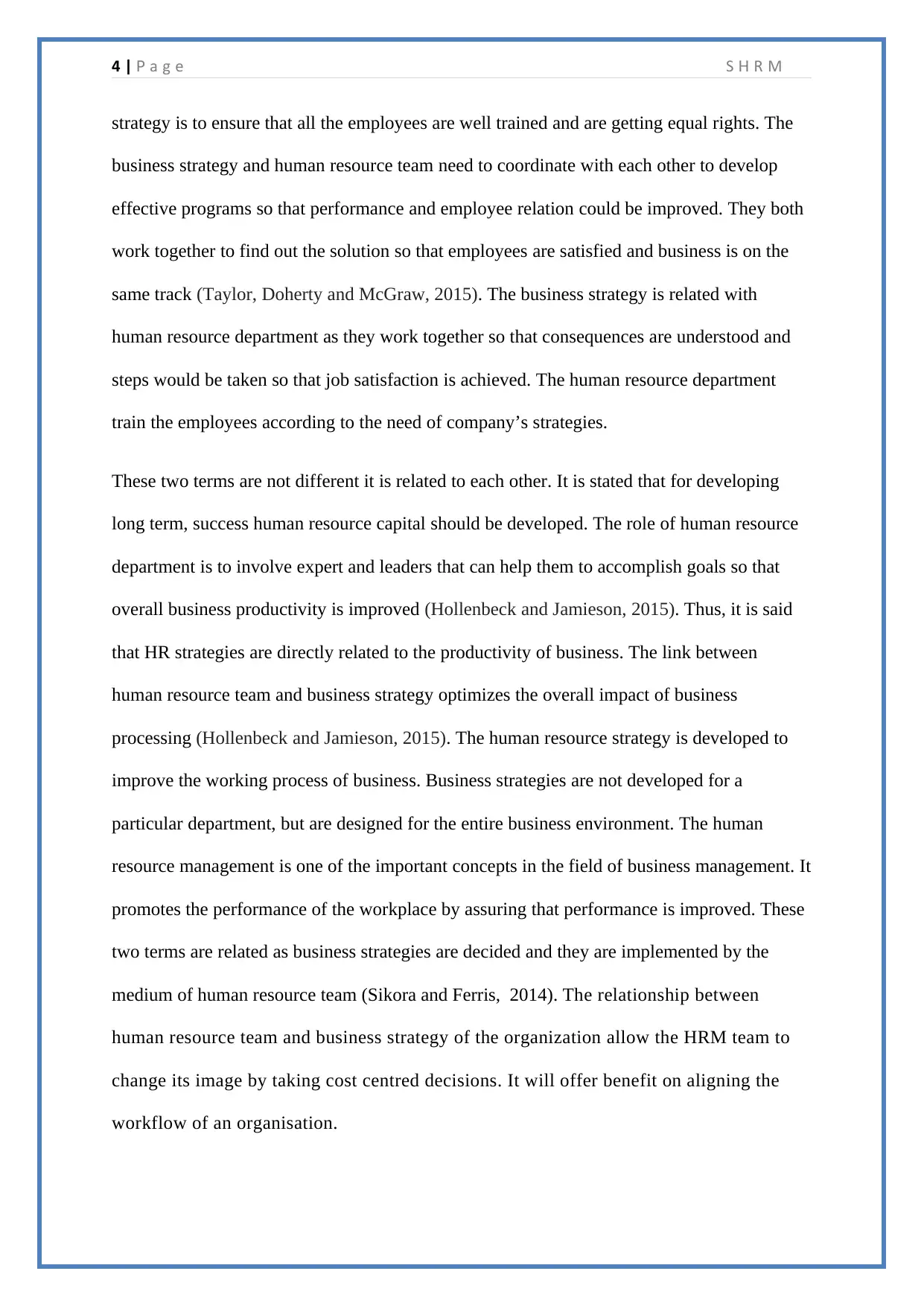
4 | a g eP S R MH
strategy is to ensure that all the employees are well trained and are getting equal rights. The
business strategy and human resource team need to coordinate with each other to develop
effective programs so that performance and employee relation could be improved. They both
work together to find out the solution so that employees are satisfied and business is on the
same track (Taylor, Doherty and McGraw, 2015). The business strategy is related with
human resource department as they work together so that consequences are understood and
steps would be taken so that job satisfaction is achieved. The human resource department
train the employees according to the need of company’s strategies.
These two terms are not different it is related to each other. It is stated that for developing
long term, success human resource capital should be developed. The role of human resource
department is to involve expert and leaders that can help them to accomplish goals so that
overall business productivity is improved (Hollenbeck and Jamieson, 2015). Thus, it is said
that HR strategies are directly related to the productivity of business. The link between
human resource team and business strategy optimizes the overall impact of business
processing (Hollenbeck and Jamieson, 2015). The human resource strategy is developed to
improve the working process of business. Business strategies are not developed for a
particular department, but are designed for the entire business environment. The human
resource management is one of the important concepts in the field of business management. It
promotes the performance of the workplace by assuring that performance is improved. These
two terms are related as business strategies are decided and they are implemented by the
medium of human resource team (Sikora and Ferris, 2014). The relationship between
human resource team and business strategy of the organization allow the HRM team to
change its image by taking cost centred decisions. It will offer benefit on aligning the
workflow of an organisation.
strategy is to ensure that all the employees are well trained and are getting equal rights. The
business strategy and human resource team need to coordinate with each other to develop
effective programs so that performance and employee relation could be improved. They both
work together to find out the solution so that employees are satisfied and business is on the
same track (Taylor, Doherty and McGraw, 2015). The business strategy is related with
human resource department as they work together so that consequences are understood and
steps would be taken so that job satisfaction is achieved. The human resource department
train the employees according to the need of company’s strategies.
These two terms are not different it is related to each other. It is stated that for developing
long term, success human resource capital should be developed. The role of human resource
department is to involve expert and leaders that can help them to accomplish goals so that
overall business productivity is improved (Hollenbeck and Jamieson, 2015). Thus, it is said
that HR strategies are directly related to the productivity of business. The link between
human resource team and business strategy optimizes the overall impact of business
processing (Hollenbeck and Jamieson, 2015). The human resource strategy is developed to
improve the working process of business. Business strategies are not developed for a
particular department, but are designed for the entire business environment. The human
resource management is one of the important concepts in the field of business management. It
promotes the performance of the workplace by assuring that performance is improved. These
two terms are related as business strategies are decided and they are implemented by the
medium of human resource team (Sikora and Ferris, 2014). The relationship between
human resource team and business strategy of the organization allow the HRM team to
change its image by taking cost centred decisions. It will offer benefit on aligning the
workflow of an organisation.
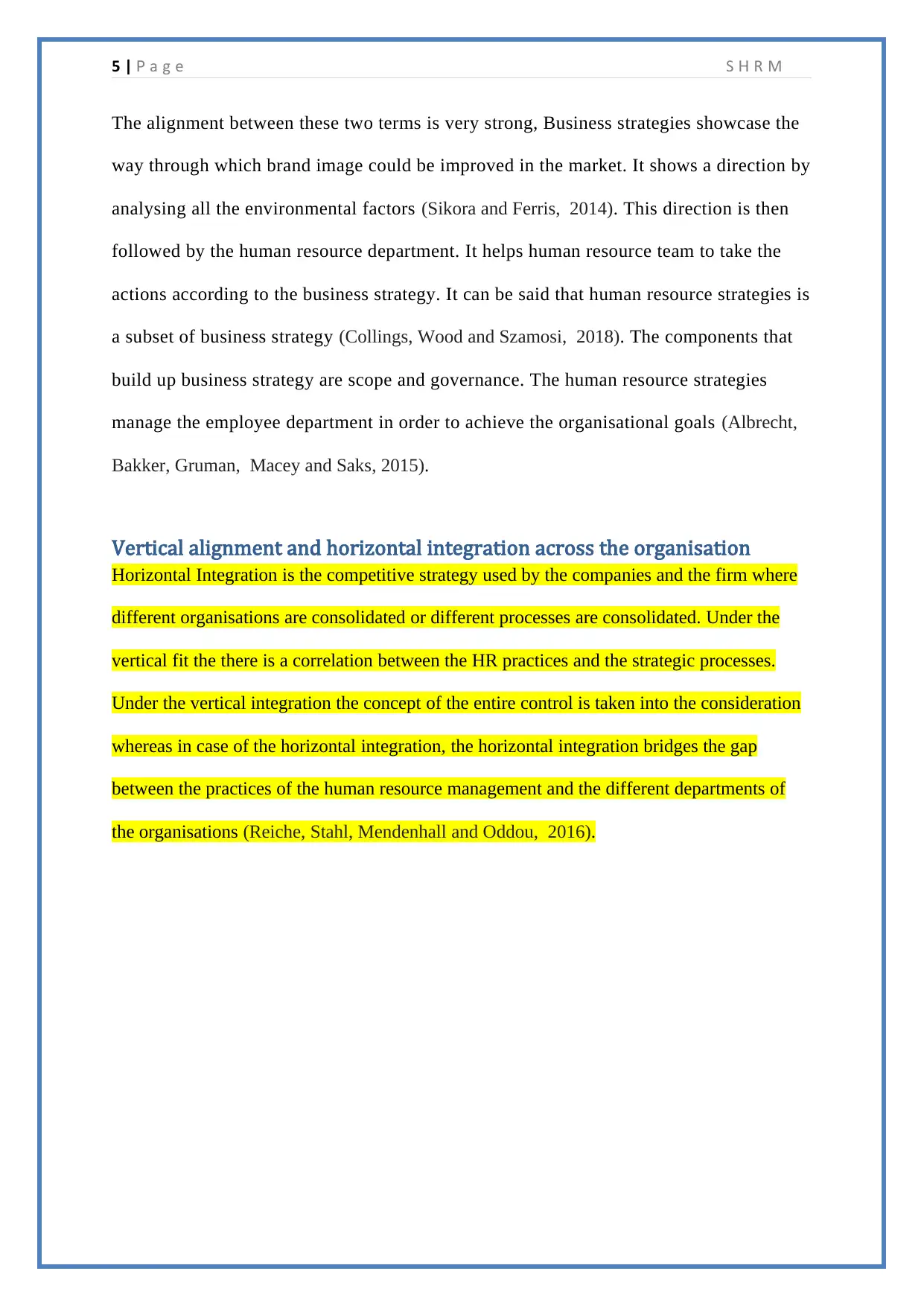
5 | a g eP S R MH
The alignment between these two terms is very strong, Business strategies showcase the
way through which brand image could be improved in the market. It shows a direction by
analysing all the environmental factors (Sikora and Ferris, 2014). This direction is then
followed by the human resource department. It helps human resource team to take the
actions according to the business strategy. It can be said that human resource strategies is
a subset of business strategy (Collings, Wood and Szamosi, 2018). The components that
build up business strategy are scope and governance. The human resource strategies
manage the employee department in order to achieve the organisational goals (Albrecht,
Bakker, Gruman, Macey and Saks, 2015).
Vertical alignment and horizontal integration across the organisation
Horizontal Integration is the competitive strategy used by the companies and the firm where
different organisations are consolidated or different processes are consolidated. Under the
vertical fit the there is a correlation between the HR practices and the strategic processes.
Under the vertical integration the concept of the entire control is taken into the consideration
whereas in case of the horizontal integration, the horizontal integration bridges the gap
between the practices of the human resource management and the different departments of
the organisations (Reiche, Stahl, Mendenhall and Oddou, 2016).
The alignment between these two terms is very strong, Business strategies showcase the
way through which brand image could be improved in the market. It shows a direction by
analysing all the environmental factors (Sikora and Ferris, 2014). This direction is then
followed by the human resource department. It helps human resource team to take the
actions according to the business strategy. It can be said that human resource strategies is
a subset of business strategy (Collings, Wood and Szamosi, 2018). The components that
build up business strategy are scope and governance. The human resource strategies
manage the employee department in order to achieve the organisational goals (Albrecht,
Bakker, Gruman, Macey and Saks, 2015).
Vertical alignment and horizontal integration across the organisation
Horizontal Integration is the competitive strategy used by the companies and the firm where
different organisations are consolidated or different processes are consolidated. Under the
vertical fit the there is a correlation between the HR practices and the strategic processes.
Under the vertical integration the concept of the entire control is taken into the consideration
whereas in case of the horizontal integration, the horizontal integration bridges the gap
between the practices of the human resource management and the different departments of
the organisations (Reiche, Stahl, Mendenhall and Oddou, 2016).
⊘ This is a preview!⊘
Do you want full access?
Subscribe today to unlock all pages.

Trusted by 1+ million students worldwide
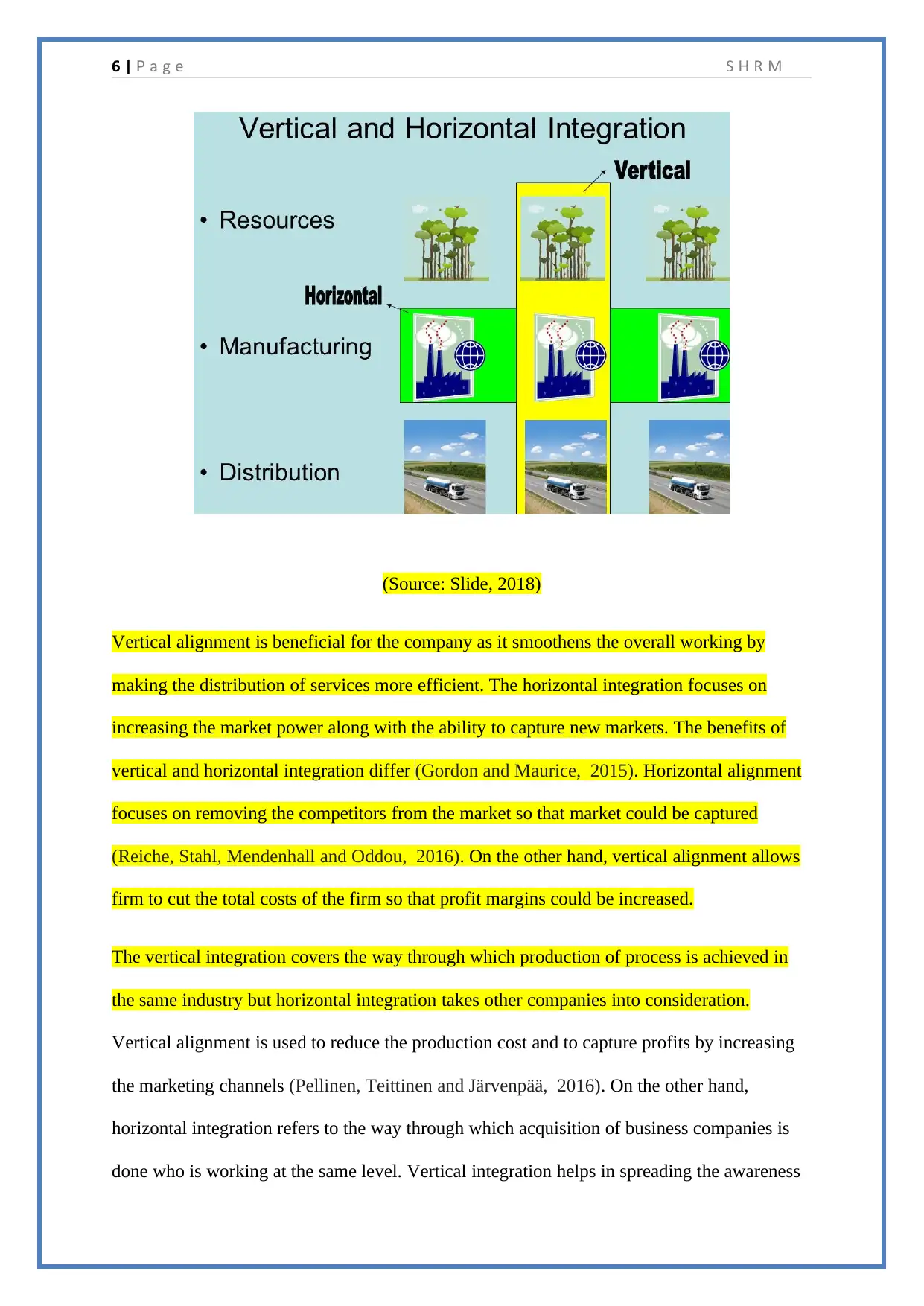
6 | a g eP S R MH
(Source: Slide, 2018)
Vertical alignment is beneficial for the company as it smoothens the overall working by
making the distribution of services more efficient. The horizontal integration focuses on
increasing the market power along with the ability to capture new markets. The benefits of
vertical and horizontal integration differ (Gordon and Maurice, 2015). Horizontal alignment
focuses on removing the competitors from the market so that market could be captured
(Reiche, Stahl, Mendenhall and Oddou, 2016). On the other hand, vertical alignment allows
firm to cut the total costs of the firm so that profit margins could be increased.
The vertical integration covers the way through which production of process is achieved in
the same industry but horizontal integration takes other companies into consideration.
Vertical alignment is used to reduce the production cost and to capture profits by increasing
the marketing channels (Pellinen, Teittinen and Järvenpää, 2016). On the other hand,
horizontal integration refers to the way through which acquisition of business companies is
done who is working at the same level. Vertical integration helps in spreading the awareness
(Source: Slide, 2018)
Vertical alignment is beneficial for the company as it smoothens the overall working by
making the distribution of services more efficient. The horizontal integration focuses on
increasing the market power along with the ability to capture new markets. The benefits of
vertical and horizontal integration differ (Gordon and Maurice, 2015). Horizontal alignment
focuses on removing the competitors from the market so that market could be captured
(Reiche, Stahl, Mendenhall and Oddou, 2016). On the other hand, vertical alignment allows
firm to cut the total costs of the firm so that profit margins could be increased.
The vertical integration covers the way through which production of process is achieved in
the same industry but horizontal integration takes other companies into consideration.
Vertical alignment is used to reduce the production cost and to capture profits by increasing
the marketing channels (Pellinen, Teittinen and Järvenpää, 2016). On the other hand,
horizontal integration refers to the way through which acquisition of business companies is
done who is working at the same level. Vertical integration helps in spreading the awareness
Paraphrase This Document
Need a fresh take? Get an instant paraphrase of this document with our AI Paraphraser
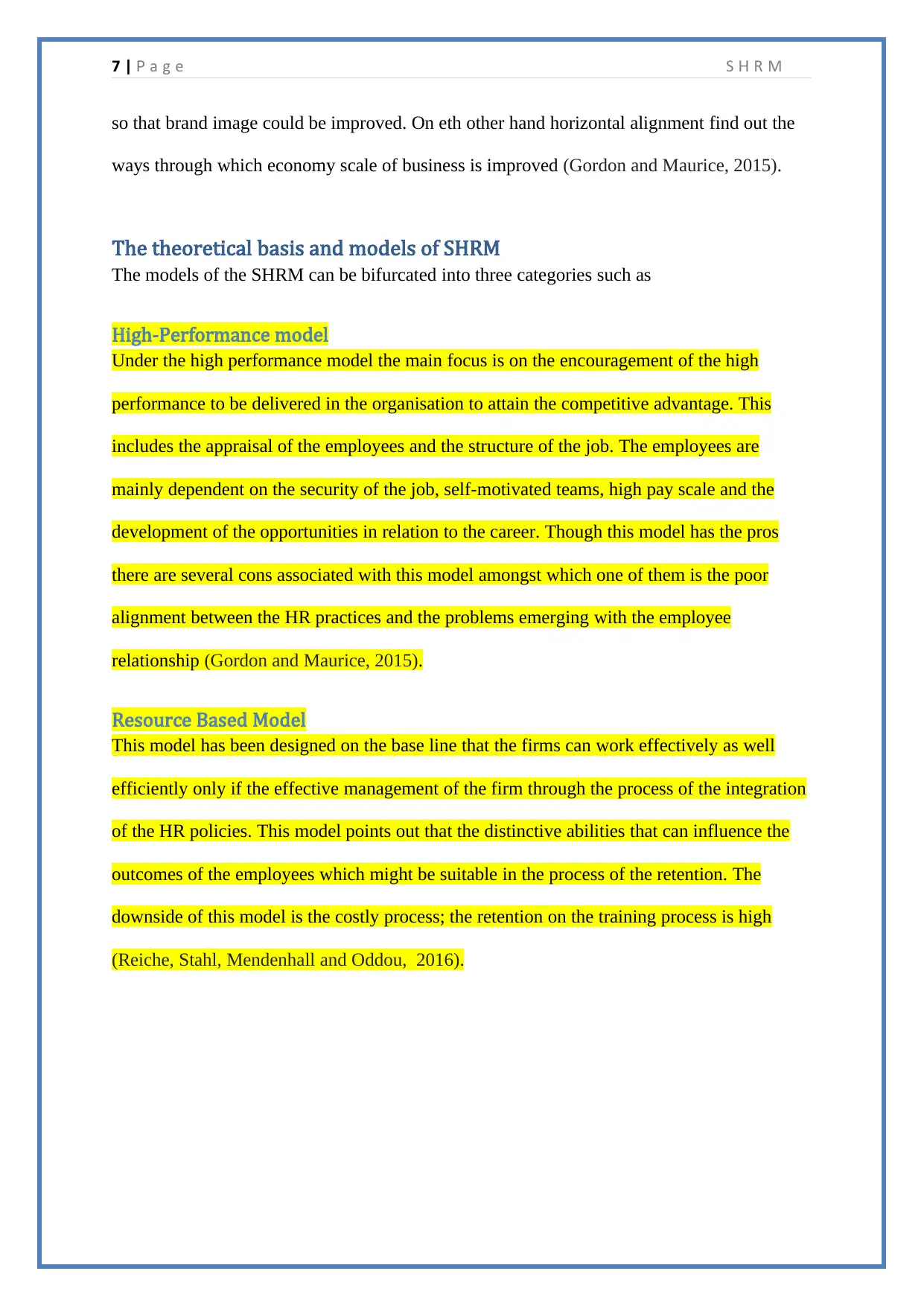
7 | a g eP S R MH
so that brand image could be improved. On eth other hand horizontal alignment find out the
ways through which economy scale of business is improved (Gordon and Maurice, 2015).
The theoretical basis and models of SHRM
The models of the SHRM can be bifurcated into three categories such as
High-Performance model
Under the high performance model the main focus is on the encouragement of the high
performance to be delivered in the organisation to attain the competitive advantage. This
includes the appraisal of the employees and the structure of the job. The employees are
mainly dependent on the security of the job, self-motivated teams, high pay scale and the
development of the opportunities in relation to the career. Though this model has the pros
there are several cons associated with this model amongst which one of them is the poor
alignment between the HR practices and the problems emerging with the employee
relationship (Gordon and Maurice, 2015).
Resource Based Model
This model has been designed on the base line that the firms can work effectively as well
efficiently only if the effective management of the firm through the process of the integration
of the HR policies. This model points out that the distinctive abilities that can influence the
outcomes of the employees which might be suitable in the process of the retention. The
downside of this model is the costly process; the retention on the training process is high
(Reiche, Stahl, Mendenhall and Oddou, 2016).
so that brand image could be improved. On eth other hand horizontal alignment find out the
ways through which economy scale of business is improved (Gordon and Maurice, 2015).
The theoretical basis and models of SHRM
The models of the SHRM can be bifurcated into three categories such as
High-Performance model
Under the high performance model the main focus is on the encouragement of the high
performance to be delivered in the organisation to attain the competitive advantage. This
includes the appraisal of the employees and the structure of the job. The employees are
mainly dependent on the security of the job, self-motivated teams, high pay scale and the
development of the opportunities in relation to the career. Though this model has the pros
there are several cons associated with this model amongst which one of them is the poor
alignment between the HR practices and the problems emerging with the employee
relationship (Gordon and Maurice, 2015).
Resource Based Model
This model has been designed on the base line that the firms can work effectively as well
efficiently only if the effective management of the firm through the process of the integration
of the HR policies. This model points out that the distinctive abilities that can influence the
outcomes of the employees which might be suitable in the process of the retention. The
downside of this model is the costly process; the retention on the training process is high
(Reiche, Stahl, Mendenhall and Oddou, 2016).

8 | a g eP S R MH
(Source: Human Resources Today, 2019)
Competency model
This model assists to give the structured form in the process of the recruitment and the
performance management activities. This model is aligned with the creation of the program,
and helps in bringing out the advancements in the workers and tends to bring out the best
among the employees. Furthermore, the drawback can be this model does not support the
recruitment of unskilled individuals (Huang, 2016).
Recommendation
Before suggesting on the policy to the client, I would like to give a short description about
some of the strategic perspectives like Best Contingency, Best Universalist and Resource
Based View. The best fit model of HR department looks at strategies that take place in
business and then focus on best strategy. The Best Universalist approach is designed so that it
can be used in all the cases under all the circumstances. In this approach the employees who
perform well are appreciated. The universal approach fits correctly in the entire situation but
(Source: Human Resources Today, 2019)
Competency model
This model assists to give the structured form in the process of the recruitment and the
performance management activities. This model is aligned with the creation of the program,
and helps in bringing out the advancements in the workers and tends to bring out the best
among the employees. Furthermore, the drawback can be this model does not support the
recruitment of unskilled individuals (Huang, 2016).
Recommendation
Before suggesting on the policy to the client, I would like to give a short description about
some of the strategic perspectives like Best Contingency, Best Universalist and Resource
Based View. The best fit model of HR department looks at strategies that take place in
business and then focus on best strategy. The Best Universalist approach is designed so that it
can be used in all the cases under all the circumstances. In this approach the employees who
perform well are appreciated. The universal approach fits correctly in the entire situation but
⊘ This is a preview!⊘
Do you want full access?
Subscribe today to unlock all pages.

Trusted by 1+ million students worldwide
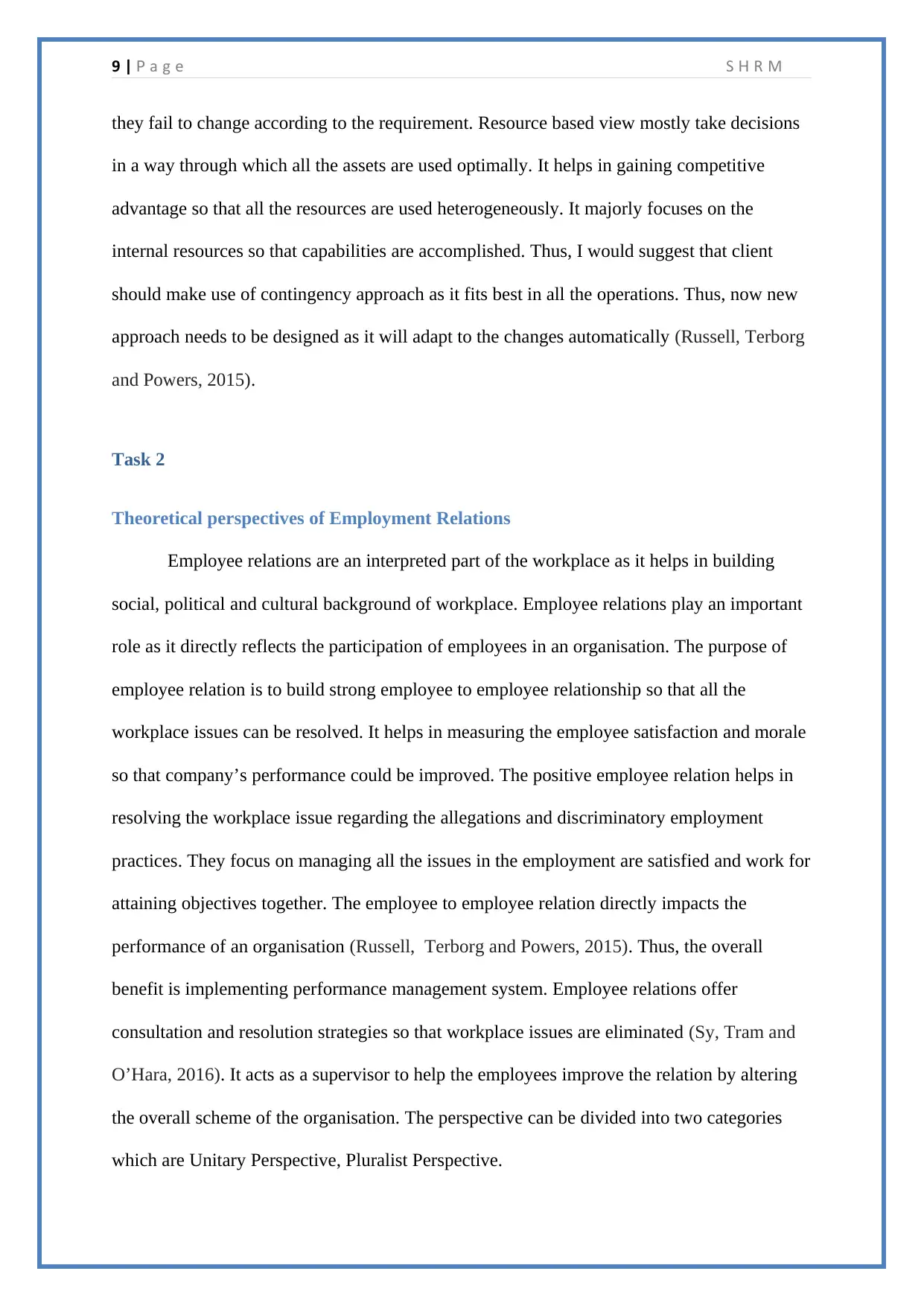
9 | a g eP S R MH
they fail to change according to the requirement. Resource based view mostly take decisions
in a way through which all the assets are used optimally. It helps in gaining competitive
advantage so that all the resources are used heterogeneously. It majorly focuses on the
internal resources so that capabilities are accomplished. Thus, I would suggest that client
should make use of contingency approach as it fits best in all the operations. Thus, now new
approach needs to be designed as it will adapt to the changes automatically (Russell, Terborg
and Powers, 2015).
Task 2
Theoretical perspectives of Employment Relations
Employee relations are an interpreted part of the workplace as it helps in building
social, political and cultural background of workplace. Employee relations play an important
role as it directly reflects the participation of employees in an organisation. The purpose of
employee relation is to build strong employee to employee relationship so that all the
workplace issues can be resolved. It helps in measuring the employee satisfaction and morale
so that company’s performance could be improved. The positive employee relation helps in
resolving the workplace issue regarding the allegations and discriminatory employment
practices. They focus on managing all the issues in the employment are satisfied and work for
attaining objectives together. The employee to employee relation directly impacts the
performance of an organisation (Russell, Terborg and Powers, 2015). Thus, the overall
benefit is implementing performance management system. Employee relations offer
consultation and resolution strategies so that workplace issues are eliminated (Sy, Tram and
O’Hara, 2016). It acts as a supervisor to help the employees improve the relation by altering
the overall scheme of the organisation. The perspective can be divided into two categories
which are Unitary Perspective, Pluralist Perspective.
they fail to change according to the requirement. Resource based view mostly take decisions
in a way through which all the assets are used optimally. It helps in gaining competitive
advantage so that all the resources are used heterogeneously. It majorly focuses on the
internal resources so that capabilities are accomplished. Thus, I would suggest that client
should make use of contingency approach as it fits best in all the operations. Thus, now new
approach needs to be designed as it will adapt to the changes automatically (Russell, Terborg
and Powers, 2015).
Task 2
Theoretical perspectives of Employment Relations
Employee relations are an interpreted part of the workplace as it helps in building
social, political and cultural background of workplace. Employee relations play an important
role as it directly reflects the participation of employees in an organisation. The purpose of
employee relation is to build strong employee to employee relationship so that all the
workplace issues can be resolved. It helps in measuring the employee satisfaction and morale
so that company’s performance could be improved. The positive employee relation helps in
resolving the workplace issue regarding the allegations and discriminatory employment
practices. They focus on managing all the issues in the employment are satisfied and work for
attaining objectives together. The employee to employee relation directly impacts the
performance of an organisation (Russell, Terborg and Powers, 2015). Thus, the overall
benefit is implementing performance management system. Employee relations offer
consultation and resolution strategies so that workplace issues are eliminated (Sy, Tram and
O’Hara, 2016). It acts as a supervisor to help the employees improve the relation by altering
the overall scheme of the organisation. The perspective can be divided into two categories
which are Unitary Perspective, Pluralist Perspective.
Paraphrase This Document
Need a fresh take? Get an instant paraphrase of this document with our AI Paraphraser
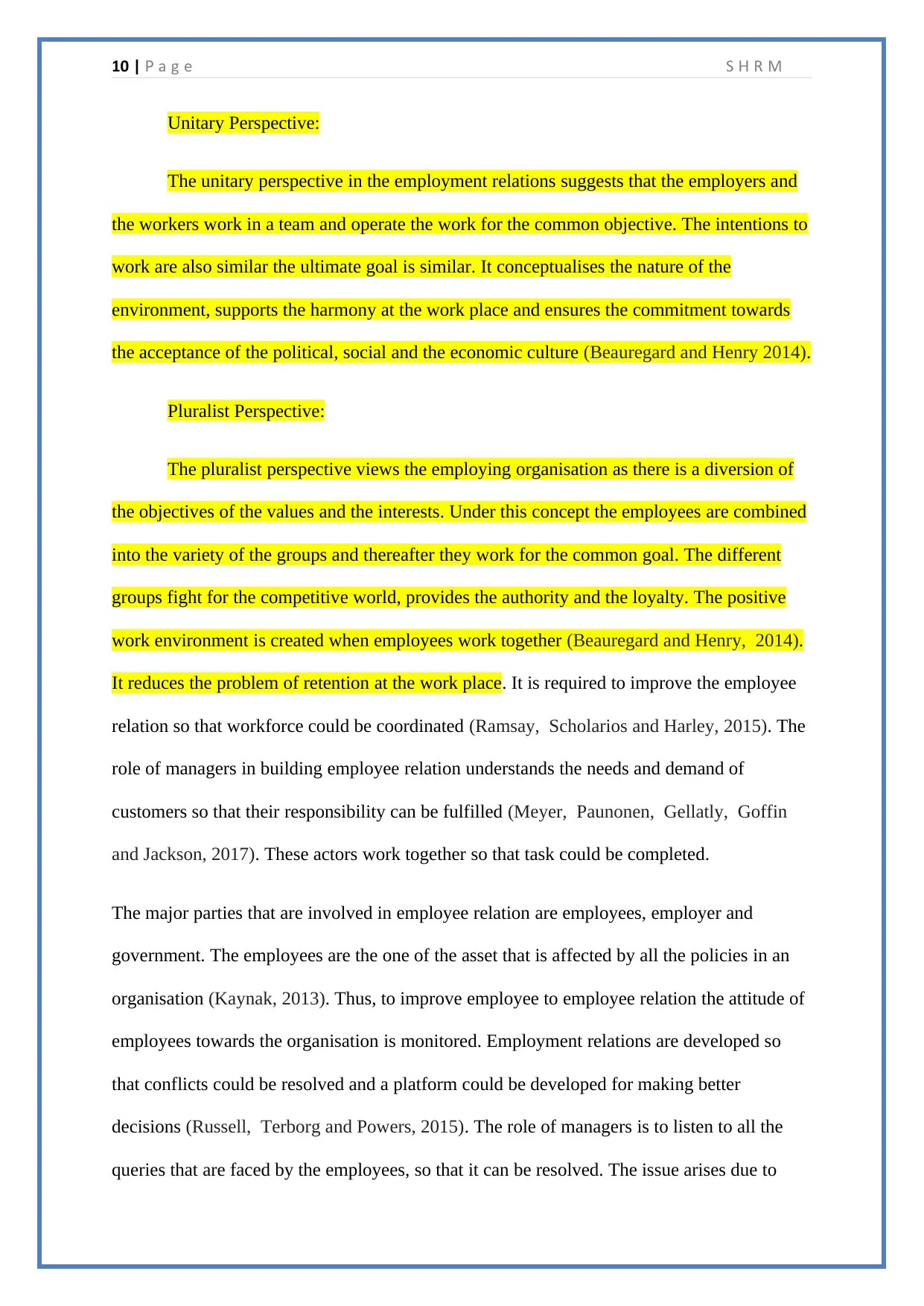
10 | a g eP S R MH
Unitary Perspective:
The unitary perspective in the employment relations suggests that the employers and
the workers work in a team and operate the work for the common objective. The intentions to
work are also similar the ultimate goal is similar. It conceptualises the nature of the
environment, supports the harmony at the work place and ensures the commitment towards
the acceptance of the political, social and the economic culture (Beauregard and Henry 2014).
Pluralist Perspective:
The pluralist perspective views the employing organisation as there is a diversion of
the objectives of the values and the interests. Under this concept the employees are combined
into the variety of the groups and thereafter they work for the common goal. The different
groups fight for the competitive world, provides the authority and the loyalty. The positive
work environment is created when employees work together (Beauregard and Henry, 2014).
It reduces the problem of retention at the work place. It is required to improve the employee
relation so that workforce could be coordinated (Ramsay, Scholarios and Harley, 2015). The
role of managers in building employee relation understands the needs and demand of
customers so that their responsibility can be fulfilled (Meyer, Paunonen, Gellatly, Goffin
and Jackson, 2017). These actors work together so that task could be completed.
The major parties that are involved in employee relation are employees, employer and
government. The employees are the one of the asset that is affected by all the policies in an
organisation (Kaynak, 2013). Thus, to improve employee to employee relation the attitude of
employees towards the organisation is monitored. Employment relations are developed so
that conflicts could be resolved and a platform could be developed for making better
decisions (Russell, Terborg and Powers, 2015). The role of managers is to listen to all the
queries that are faced by the employees, so that it can be resolved. The issue arises due to
Unitary Perspective:
The unitary perspective in the employment relations suggests that the employers and
the workers work in a team and operate the work for the common objective. The intentions to
work are also similar the ultimate goal is similar. It conceptualises the nature of the
environment, supports the harmony at the work place and ensures the commitment towards
the acceptance of the political, social and the economic culture (Beauregard and Henry 2014).
Pluralist Perspective:
The pluralist perspective views the employing organisation as there is a diversion of
the objectives of the values and the interests. Under this concept the employees are combined
into the variety of the groups and thereafter they work for the common goal. The different
groups fight for the competitive world, provides the authority and the loyalty. The positive
work environment is created when employees work together (Beauregard and Henry, 2014).
It reduces the problem of retention at the work place. It is required to improve the employee
relation so that workforce could be coordinated (Ramsay, Scholarios and Harley, 2015). The
role of managers in building employee relation understands the needs and demand of
customers so that their responsibility can be fulfilled (Meyer, Paunonen, Gellatly, Goffin
and Jackson, 2017). These actors work together so that task could be completed.
The major parties that are involved in employee relation are employees, employer and
government. The employees are the one of the asset that is affected by all the policies in an
organisation (Kaynak, 2013). Thus, to improve employee to employee relation the attitude of
employees towards the organisation is monitored. Employment relations are developed so
that conflicts could be resolved and a platform could be developed for making better
decisions (Russell, Terborg and Powers, 2015). The role of managers is to listen to all the
queries that are faced by the employees, so that it can be resolved. The issue arises due to

11 | a g eP S R MH
diversity at the workplace, inequality or poor working environment (Meyer, Paunonen,
Gellatly, Goffin and Jackson, 2017). These issues can be resolved by maintaining healthy
and professional relation. Creating healthy environment is one of the way through which
employees are motivated. The mangers and top management department work in a way
through which productivity of an organisation is achieved (Kakar, Raziq and Khan, 2017) .
The productivity can be gained through by building strong relations so that overall
productivity of an organisation boosts up. The importance of employee relation is that it
increases the loyalty among employees (Shore and Martin, 2015).
Role of the actors within the Employment Relationship
Human Resource- It simplifies the relation of employees at the workplace by ensuring that
standards are met and all the concerns of employees by making sure that requests are met.
The function of human resource department is improving the workplace quality so that
effectiveness of employees is improved (Huang, 2016). They design policies so that equality
is generated at the workplace. It is the role of human resource department to listen to the
complaints of co-workers and then help employees by designing new policies. They relocate
the work if there is burden in any department to other (Shore and Martin, 2015).
Senior management- The senior management plays an important role in listening to the issues
that are raised by the employee. Additionally, they find out ways through which employees
can be appraised for their performance and are rewarded (Kakar, Raziq and Khan, 2017) .
They execute employee assistance programs so that problems could be overcome.
Leaders- The failure faced among employees can directly have negative impact on the
employee relation (Kaynak, 2013). Thus, leaders take all the sessions into consideration and
then directly interact with the employees so that their issue could be resolved (Purandare and
Chandak, 2015). There are various cases very employees become unsatisfied and they decide
diversity at the workplace, inequality or poor working environment (Meyer, Paunonen,
Gellatly, Goffin and Jackson, 2017). These issues can be resolved by maintaining healthy
and professional relation. Creating healthy environment is one of the way through which
employees are motivated. The mangers and top management department work in a way
through which productivity of an organisation is achieved (Kakar, Raziq and Khan, 2017) .
The productivity can be gained through by building strong relations so that overall
productivity of an organisation boosts up. The importance of employee relation is that it
increases the loyalty among employees (Shore and Martin, 2015).
Role of the actors within the Employment Relationship
Human Resource- It simplifies the relation of employees at the workplace by ensuring that
standards are met and all the concerns of employees by making sure that requests are met.
The function of human resource department is improving the workplace quality so that
effectiveness of employees is improved (Huang, 2016). They design policies so that equality
is generated at the workplace. It is the role of human resource department to listen to the
complaints of co-workers and then help employees by designing new policies. They relocate
the work if there is burden in any department to other (Shore and Martin, 2015).
Senior management- The senior management plays an important role in listening to the issues
that are raised by the employee. Additionally, they find out ways through which employees
can be appraised for their performance and are rewarded (Kakar, Raziq and Khan, 2017) .
They execute employee assistance programs so that problems could be overcome.
Leaders- The failure faced among employees can directly have negative impact on the
employee relation (Kaynak, 2013). Thus, leaders take all the sessions into consideration and
then directly interact with the employees so that their issue could be resolved (Purandare and
Chandak, 2015). There are various cases very employees become unsatisfied and they decide
⊘ This is a preview!⊘
Do you want full access?
Subscribe today to unlock all pages.

Trusted by 1+ million students worldwide
1 out of 19
Related Documents
Your All-in-One AI-Powered Toolkit for Academic Success.
+13062052269
info@desklib.com
Available 24*7 on WhatsApp / Email
![[object Object]](/_next/static/media/star-bottom.7253800d.svg)
Unlock your academic potential
Copyright © 2020–2025 A2Z Services. All Rights Reserved. Developed and managed by ZUCOL.




